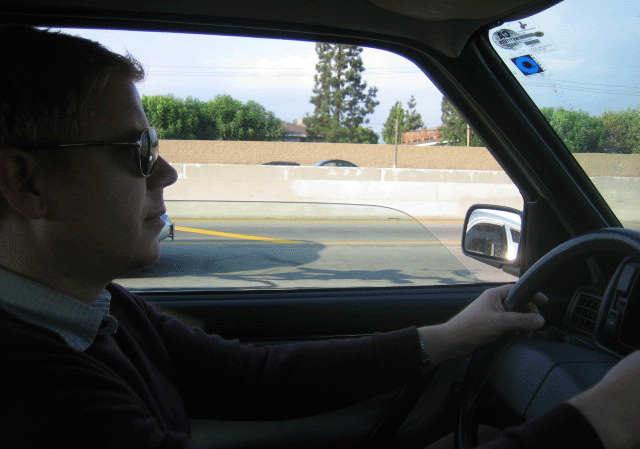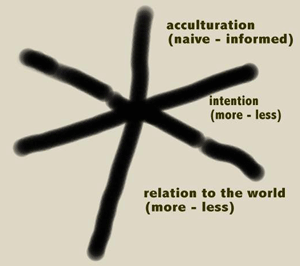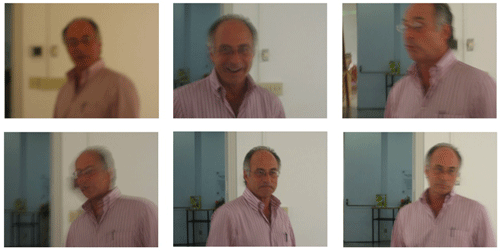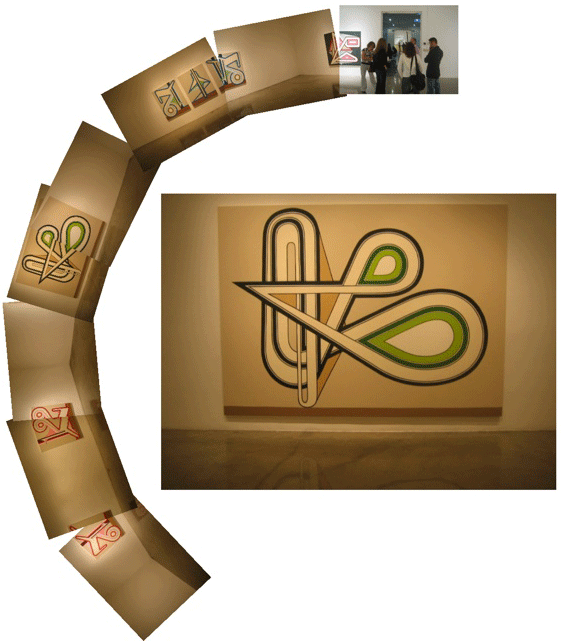October 20, 2006
Bart's Opening

Bart was invited by David Pagel to show his paintings at the east gallery of Claremont, my old grad school back in '91. I hadn't visited the school since perhaps '93 and I thought that it would be great to see the place again and maybe run into a few of the faculty that might still be there.
Since I am spearheading the scooter revolution in Los Angeles*, I get to bum rides to distant places and who better than Bart himself? Claremont is roughly an hour's drive East on the San Bernadino (10) Freeway. It was a good oportunity to hang out and charlar with the wind in our hair, as they say.
So we got on the road, looking for the freeway entrance and Bart started talking about his drawing class at UCLA. He has brought them through the marvels of the basics of drawing and through the world of the figure. Now they're ready for abstraction. But how should he format the class?
Already on the freeway, we were lost.
We were headed north on the Pasadena (110) Freeway but we forgot that there was no entrance south from there. No matter, we shot up through the arroyo and we looped back around south towards the Golden State (5) Freeway.
Cool.
We resumed. Where can you start introducing young artists to abstraction? You give them a map. What are the various ways to enter into abstract painting? Is there a limited number of them? Isn't there a kind of wholeness to the various ways to manifest abstraction, like there is in describing a human figure: head, torso, limbs? Is there a pattern to the list?
Dang!
We missed the left side on ramp to the San Bernardino (10) Freeway. We were hurtling south on the Golden State toward San Diego and we had to get off and turn around again. This time, I promised to stay quiet until the turn. Around Fourth Street, we flipped around and found the San Bernardino freeway.
Now, we are on the road.
Now, we can make the list.
What are the various ways that one can manifest abstraction?
We had a long ride in front of us. It was information dump time:
GENERATORS OF ABSTRACTION
-As a reduction of the World.
Imagery taken from the world as in the tracings of Ingrid Calame, orEllsworth Kelly:He began to create pictures abstracted from fragments of the seen world, such as windows, plant forms and shadows falling onto a flight of steps along with composite works, assembled from a number of panels each painted a single, uniform colour...-Accident.
Like Duchamp dropping a string:...In the early 20th century, Dada artists advocated chance techniques in the visual arts. A good example is Marcel Duchamp's random string painting, entitled Network Stoppages, which was created by dropping a set of strings from a height of one meter and tracing their outlines. Similarly the father of modern collage, Kurt Schwitters, created his artworks by dropping pieces of colored paper and other materials on a canvas (Hughes, 1991)...-Laws of Visual Perception
-When the laws of mimesis are unbound, you still have the universe of visual perception which undergirds it: Gombrich, Arnheim, and the rest. Balance, Shape, Form, Color, there is a kind of periodic table for visual perception, a finite number of aspects which frame visuality.Students could toggle through the categories. You could make that paper folding game that little girls crafted in grade school. Pick a color." "Pick your favorite number." Then, with rythmn, they sung: "My mama told me that you..." The categories would be shape, balance, color, etc. of course.
-Automatism
Muscle twitch stuff, think about heaven. Put a pencil in your hand and spaz out with a sense of purpose. Channel your spirit or somesuch. Pollack's fling, beer dripping down the chin. Paul Klee's Jungian space. Chamberlain's whatever.
Then we ran dry. Any other idea became a hybrid of these four. Was there a pattern here?
Well, yes there was:

We realized that the four generators could be grouped into two: one in terms of mimesis, or some kind of representation of the world and another in terms of intention. It formed an x-y horizontal axis and one could interpolate between them. We had a north and a south... but was there a vertical dimension? Yes --one of culture-- the relation to the history of art. An XYZ axis! Supercool, now the students have a compass. Maybe, if they're smart, they can navigate their way into the non-objective visual world, maybe they can chart where they are and where they might want to go.
Not bad for work done during a commute.

We finally arrived at Claremont. We found David Pagel in a faculty meeting with Connie Zher and Michael Brewster. Michael Brewster! Sculptor of sound, longtime faculty honcho at the school. I hadn't seen him for many moons, it was great to shake hands again. We busted up their meeting and immediately, Michael wanted to steal away towards a local bar for a glass of somesuch and toast the ocassion, to catch up before the opening.

This shot messes with Bart's intentions, but you might get a feel for the installation anyway. Bart said that he didn't anticipate the rigidity of the square plan of the gallery, the leadened symmetry of the room probably weighted his strategy of the jumping compositions.

It was good to catch up with John Millei and David Amico (not pictured, Dave stepped off before the show opened --you're busted, Dave!). The younger students sought Bart out, the older ones stood aloof tot he side, too cool for school.

After the show, we trekked back to LA, a 50 minute debrief on the show. Shooting back past downtown, we detoured towards the Mandrake, the site of Joel's going away party. He's off to NYC, the next chapter in the Mesler saga. Everyone was sad about it, as if a big engine was dropping off the plane... but you know, this world is too small to think that way. Ultimately, I think we will all be bicoastal in one way or the other.
Besides, we will all have to fly to NY more often, won't we?

*I am holding the mental image of Los Angeles becoming like Taipei, a throng of scooters someday soon. (Now you are as well.)
Posted by Dennis at October 20, 2006 12:32 AM
Leave a comment